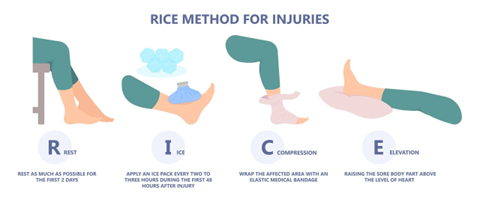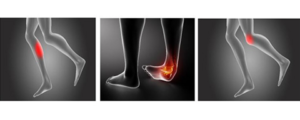What are they?
Soft tissue injuries such as sprains, strains and contusions are an injury of the muscle, tendon or ligament. These types of injuries can be mild to severely painful depending on how extensive the damage is to the soft tissue structure.
A Sprain is a soft tissue injury that effects our ligaments (tissue that connects bone to bone). Sprains are classified into three grades of severity: Slight stretching and some damage to the ligamentous fibers (grade 1), Partial tearing and abnormal laxity of the joint (grade 2) and complete tear resulting in joint instability (grade 3). Generally, the severity of the injury will coincide with the intensity of pain, swelling and bruising.
A Strain is a soft tissue injury that affects our muscles and tendons (soft tissue that connects muscle to bone). Just like a sprain, strains are classified into the same 3 categories of Grade 1, 2 and 3. Symptoms of strains include pain and inflammation alongside muscle weakness instead of joint instability which is symptomatic of a sprain.
Contusions are a different type of soft tissue injury where the underlying tissues are crushed without breaking the skin. This results in pooling of blood around the injury leaving discoloration and swelling under the skin, aka a bruise.
How do they happen?
Acute soft tissue injuries such as sprains, strains and contusions occur when some type of trauma has occurred. It may be a physical blow to the body, or a fall, twist or change of direction under load. This means soft tissue injuries can occur in contact and non-contact scenarios. For example, some studies have shown that up to 70% of ACL injuries are non-contact and occur when the knee joint is under load in a change of direction scenario.
Overuse injuries such as tendinitis and bursitis are also classified as soft tissue injuries. Overuse injuries are more of an aggravation and inflammation of the tissue over time rather than an acute soft tissue injury that occurs in a short period of time.
What to do if this injury occurs?
Soft tissue injuries will respond well to the basic RICER treatment. This is Rest, Ice, Compression and Elevation. Depending on the severity of the injury, Referral is put in place to seek further medical assistance. RICER treatment is effective at treating soft tissue injuries as it immobilizes the joint and reduces swelling as quickly as possible. It is important that with these injuries, first aid such as Ricer is administered as soon as possible to ensure a speedy recovery.

Can we prevent them?
We can help prevent soft tissue injuries by training strong and resilient connective tissues, such as muscles, tendons and ligaments. A systematic review and meta-analysis by Rudisill, et al., 2023, concluded that addressing the risk factors for soft tissue injuries such as strength, flexibility and limb asymmetry can help prevent their occurrence. These risk factors can be addressed through a well-rounded strength training program tailored to an individual’s needs.
References:
Rudisill, S. S., Varady, N. H., Kucharik, M. P., Eberlin, C. T., & Martin, S. D. (2023). Evidence-Based Hamstring Injury Prevention and Risk Factor Management: A Systematic Review and Meta-analysis of Randomized Controlled Trials. The American Journal of Sports Medicine, 51(7), 1927–1942. https://doi.org/10.1177/03635465221083998



